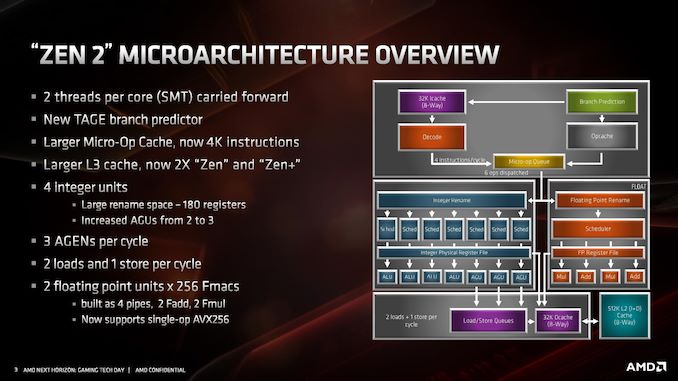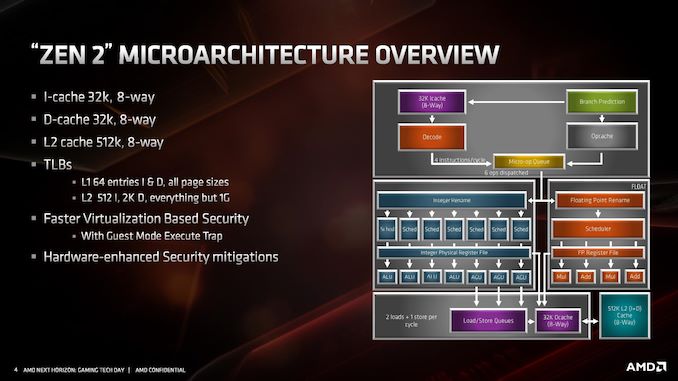AMD Zen 2 Microarchitecture Analysis: Ryzen 3000 and EPYC Rome
by Dr. Ian Cutress on June 10, 2019 7:22 PM EST- Posted in
- CPUs
- AMD
- Ryzen
- EPYC
- Infinity Fabric
- PCIe 4.0
- Zen 2
- Rome
- Ryzen 3000
- Ryzen 3rd Gen
AMD Zen 2 Microarchitecture Overview
The Quick Analysis
At AMD’s Tech Day, on hand was Fellow and Chief Architect Mike Clark to go through the changes. Mike is a great engineer to talk to, although what always amuses me (for any company, not just AMD) is that engineers that talk about the latest products coming to market are already working one, two, or three generations ahead at the company. Mike remarked that it took him a while to think back to the specific Zen+ to Zen 2 changes, while his mind internally is already several generations down the line.
An interesting element to Zen 2 is around the intention. Initially Zen 2 was merely going to be a die shrink of Zen+, going from 12nm down to 7nm, similar to what we used to see with Intel in its tick-tock model for the initial part of the century. However, based on internal analysis and the time frame for 7nm, it was decided that Zen 2 would be used as a platform for better performance, taking advantage of 7nm in multiple ways rather than just redesigning the same layout on a new process node. As a result of the adjustments, AMD is promoting a +15% IPC improvement for Zen 2 over Zen+.
When it comes down to the exact changes in the microarchitecture, what we’re fundamentally looking at is still a similar floorplan to what Zen looks like. Zen 2 is a family member of the Zen family, and not a complete redesign or different paradigm on how to process x86 – as will other architectures that have familial updates, Zen 2 affords a more efficient core and a wider core, allowing better instruction throughput.
At a high level, the core looks very much the same. Highlights of the Zen 2 design include a different L2 branch predictor known as a TAGE predictor, a doubling of the micro-op cache, a doubling of the L3 cache, an increase in integer resources, an increase in load/store resources, and support for single-operation AVX-256 (or AVX2). AMD has stated that there is no frequency penalty for AVX2, based on its energy aware frequency platform.
AMD has also made adjustments to the cache system, the most notable being for the L1 instruction cache, which has been halved to 32 kB, but associativity has doubled. This change was made for important reasons, which we’ll go into over the next pages. The L1 data cache and L2 caches are unchanged, however the translation lookaside buffers (TLBs) have increased support. AMD also states that it has added deeper virtualization support with respect to security, helping enable features further down the pipeline. As mentioned previously in this article, there are also security hardening updates.
For the quick analysis, it’s easy to tell that doubling the micro-op cache is going to offer a significant improvement to IPC in a number of scenarios, and combine that with an increase in load/store resources is going to help more instructions get pushed through. The double L3 cache is going to help in specific workloads, as would the AVX2 single-op support, but the improved branch predictor is also going to showcase raw performance uplift. All-in-all, for an on-paper analysis, AMD’s +15% IPC improvement seems like a very reasonable number to promote.
Over the next few pages, we’ll go deeper into how the microarchitecture has changed.












216 Comments
View All Comments
GreenReaper - Tuesday, June 11, 2019 - link
A lot of progress has been made. Browsers are far more multithreaded than they once were - and as web pages become more complex, that benefit can scale. Similarly, databases and rendering can scale very well over certain operations.Said scaling tends to work best for the longest operations, because they can be split up into chunks without too much overhead. The overall impact should be that there are fewer long, noticeable delays. There isn't so much progress for things that are already pretty fast - or long sequences of operations that rely on one another. (However, precomputing and prefetching can help.)
stephenbrooks - Thursday, June 13, 2019 - link
I find it surprising how they add these smallish increases onto execution width, out of order buffers, register files etc. The IPC hasn't stopped increasing, it's just slow-ish. Maybe they're fighting power and latency in those part of the core so the 2x density from a node doesn't translate fully.Santoval - Tuesday, June 11, 2019 - link
Prices should drop when the competition with Intel becomes fiercer. I don't expect that anytime soon though.. It doesn't look like Intel will manage to release Ice Lake CPUs (except apparently the -U and -Y ones they announced) this year or at all.Their 10nm+ node is still having serious issues with clocks and thermals, and the yields are much lower than TSMC's 7nm (high performance) node. So "word on the street" is that they won't release Ice Lake CPUs for desktop at all. Id est that they'll can them and release instead Tiger Lake desktop CPUs fabbed with their fixed (??) 10nm++ node variant late next year (as in Q4 2020).
piroroadkill - Wednesday, June 12, 2019 - link
You're wrong. You get more performance than Intel at a lower price. In the case of the 3950X, it's significant. To sell them cheaper would devalue an incredible product, for no reason.Targon - Thursday, June 13, 2019 - link
Ryzen 7 2700X vs. Ryzen 7 3700X. Same price, better performance. Looking at the 3800X which is $399, look at the IPC+clock speed improvements. The 3900X will obviously come at a cost, because you are getting 50% more cores for that increased price. Single threaded though....at what point do you really focus on how fast or slow a single threaded program is running in this day and age where you run dozens of processes at the same time? If you are running dozens of single threaded programs, then performance will change based on how the OS scheduler assigns them to different CPU cores.Qasar - Thursday, June 13, 2019 - link
jjj" They give us around 20% ST gains (IPC+clocks) but at a cost. " that same thing could be said about intels cpus over the last few years... how much performance increase did they give us year over year ?? all while only giving is 4 cores for the mainstream... amd's prices are just fine.. intel is the one that should be dropping their prices, some as low as the $50 you say, but most, $500 or more
Tunnah - Monday, June 10, 2019 - link
I bet now Intel is just going to completely flood ads with the title "Intel beats AMD in pure FPS tests!", because they'll get 210fps where AMD gets 200. And some people will eat it up.I'm so excited for this upgrade. Replacing a 2700K with a 3800X, where I'll not only get a doubling of cores, but clock for clock I reckon it's a 40, 50% improvement there too.
My Civ games are gonna be so zoomy now..
xrror - Monday, June 10, 2019 - link
Intel will always beat AMD ......
...
(at a price point you don't give a f*ck about) (4 digits or more)
Are you a micro-trader hardwired into the BS Stock Exchange? You think $1000+ is too much for the fully enabled processor arch you want to overclock should cost you?
Sorry, Intel doesn't have the time of day for you after 2011, after Sandy Bridge took away the ability to overclock blessed "K" skus...
oh sure, there are others. IDT and Cyrix are dead but... let me introduce you to...
AMD
xrror - Monday, June 10, 2019 - link
This isn't aimed at you Tunnah. I meant it as humor.Read my comment like some exciting infocommercial, with ... (insert commanding infomercial voice here) hehe
Makaveli - Tuesday, June 11, 2019 - link
The 2700k and the 3800X are both 8C 16T designs.